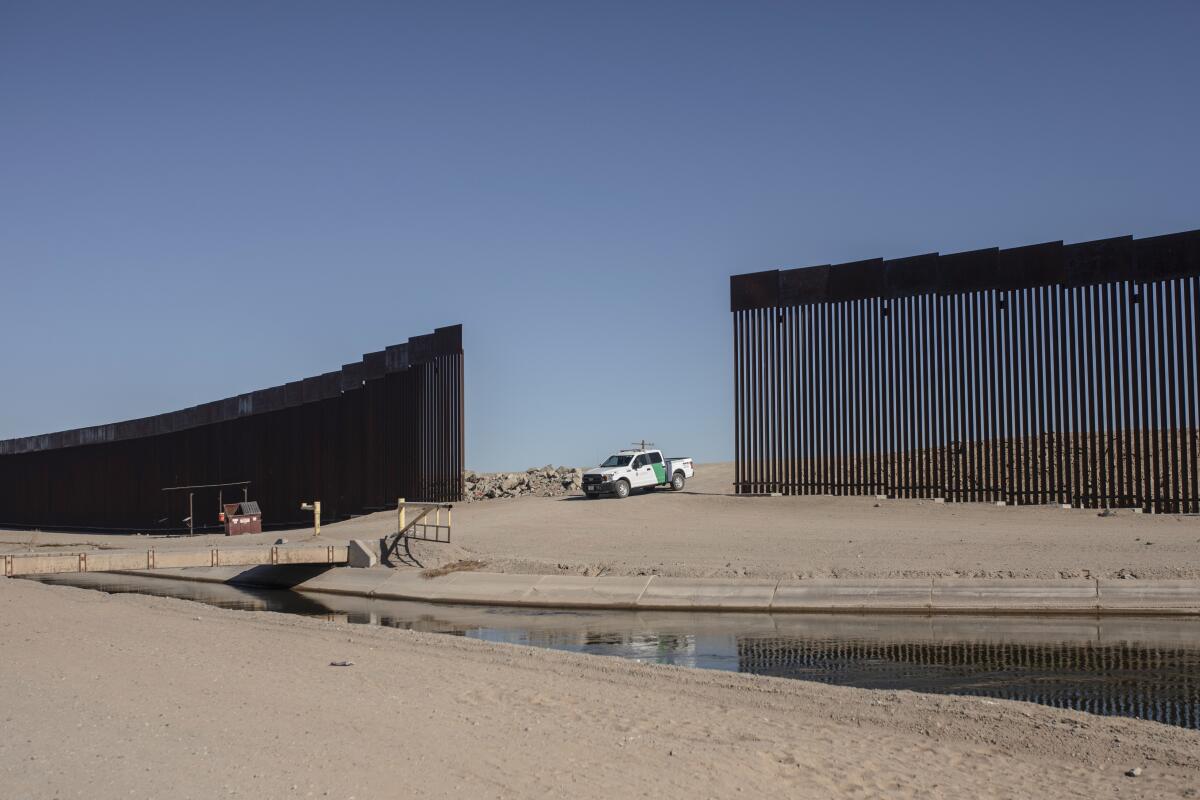U.S. preps for even busier border amid lifting of health order

- Share via
WASHINGTON — The Biden administration released a plan Tuesday to deal with an expected increase in already high numbers of migrants at the U.S.-Mexico border from the planned lifting of a public health order that prevents people from seeking asylum — and that Republican and some Democratic lawmakers insist should be kept in place.
A memo from Homeland Security Secretary Alejandro N. Mayorkas outlines a more robust effort to enforce U.S. immigration law without the use of Title 42, which was invoked at the start of the COVID-19 pandemic in March 2020.
“When the Title 42 public health order is lifted, we anticipate migration levels will increase, as smugglers will seek to take advantage of and profit from vulnerable migrants,” Mayorkas warns in a memo that comes a day before he is to testify to Congress on an issue that has become a potent element in Republican political messaging.
The plan includes increasing the number of personnel in the border region from Customs and Border Protection and other federal agencies, expanding detention capacity with the use of temporary facilities and aggressively deploying a process known as expedited removal on migrants who do not qualify for asylum or some other relief under U.S. law.
It also relies on new Department of Homeland Security initiatives intended to streamline the evaluation of migrant claims, such as the deployment of asylum officers to the border to help determine whether someone should be granted temporary legal residency until an immigration court rules on their case.
Unmentioned is the fact that a court could soon order the government to reverse course and halt plans to lift Title 42 on May 23 because of lawsuits filed by Republican-led states.
On Monday, a federal judge in Louisiana said he would issue an order limiting the administration’s ability to prepare but left specifics of the settlement to the federal government and the states.
U.S. District Judge Robert Summerhays, a President Trump appointee, has scheduled a hearing on May 13 in the lawsuit by Louisiana and 20 other states seeking to keep Title 42 authority in place. Republicans and some Democrats in Congress have also urged the Biden administration to continue the order for now.
Title 42 is a public health policy that’s being used to determine whether immigrants can cross the border. Here’s how it works.
Senate Minority Leader Mitch McConnell (R-Ky.) said Tuesday that Republicans “are going to insist” on a vote on keeping the public health order in place, likely as an amendment to a compromise $10-billion package of pandemic aid. That demand has put Democrats on the defensive ahead of fall elections in which congressional control is in play and some moderates face competitive races.
Senate Majority Leader Charles E. Schumer (D-N.Y.) conceded that the GOP effort is forcing Democrats to try finding a position they can rally behind. “There’s divisions there now,” he said. And Sen. Tim Kaine (D-Va.) took the unusual step of criticizing the administration for sending conflicting signals on the issue.
“We’re puzzled by the administration, some mixed messages around. Is the emergency over or isn’t it over?” Kaine told reporters. “We’re confused about it. And that leads different people to be in different spots until we get questions answered.”
Migrants have been expelled more than 1.8 million times under the rule, which was issued by the Centers for Disease Control and Prevention under former President Trump.
Advocates for asylum seekers support the end to the rule, which they say endangers people fleeing persecution back home and violates rights to seek protection under U.S. law and international treaty. The states challenging the administration say the U.S. is not ready for a likely influx of migrants resulting from the rule’s end, straining public services.
Child migrants often miss months or even years of schooling on their turbulent journeys. Shelters and teachers work to help in Mexico.
It comes amid what the administration concedes are historic numbers of migrants attempting to cross the border due to factors that include economic and political turmoil in Latin America, as well as a backlog of people hoping to seek asylum.
The increase in migrant encounters is also due in part to Title 42.
Immigration authorities stopped migrants 221,303 times along the southern border in March, a 33% increase from a month earlier, according to U.S. Customs and Border Protection data.
But many of those encounters were people coming back after being removed under the public health authority. CBP said the number of unique individuals encountered nationwide in March came to 159,900, still high but significantly below the total.
Biden administration officials argue that the use of expedited removal is more of a deterrent because people subjected to it are inadmissible for five years and can be charged with a felony if they attempt to return to the country. Under Title 42, there are no legal consequences and many people simply turn around and come back.
More to Read
Sign up for Essential California
The most important California stories and recommendations in your inbox every morning.
You may occasionally receive promotional content from the Los Angeles Times.












